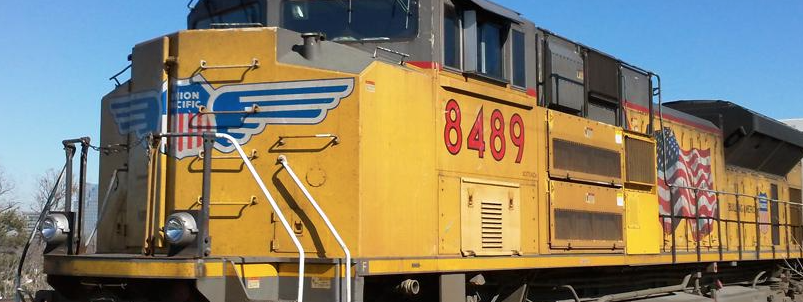[SatNews] The key behind this progress is tapping the Internet of Things to bring together the data he needs to make the railways safer—and deliver more value to one of the nation’s most enduring and revered companies ...
Union Pacific’s Lynden Tennison doesn’t exactly have a problem with “big data.” But unlike most CIOs, he wants one.

Lynden Tennison and his team are using technology to curb train derailments—and bring even more IT value to the largest U.S. railroad
Why is he asking for more data? Tennison and his colleagues are on a mission to make train derailments a true rarity. To do that, Tennison and his organization are utilizing an array of technologies—and developing new ones—to help the largest railroad in the United States to track not only its assets, but the health of those assets.
Tennison is capitalizing on the growing ability of analytics tools to work with large streams of near-constant data, to allow Union Pacific to monitor the status of its rail lines, rail cars, locomotives and other assets in real-time, improving safety and predicting—and preventing—potential equipment failures. The key behind this progress is tapping the Internet of Things to bring together the data he needs to make the railways safer—and deliver more value to one of the nation’s most enduring and revered companies.
It all started about 12 years ago, when Union Pacific deployed infrared sensors—Tennison calls them “hotbox detectors”—alongside the railroads. When a railcar comes by, it rolls over the sensor, which inspects the bearings for temperature patterns. If something is amiss, the sensor communicates the issue to the train crew, who are then responsible for inspecting the bearing with their own infrared tools.
But Tennison and his team took it a step further: They connected all the sensors to transmit information back to headquarters. With that, they wrote a number of pattern-matching algorithms that helped them better understand which patterns led to failures. “Even before the bearing reached a certain temperature, we could tell that a bearing was going to fail, and we could generally predict when that was going to happen, because we had a lot of data,” Tennison said in a recent conversation. “We didn’t just have one read from one location—but we had multiple readings from multiple locations over a period of time.”
After deploying a sensor every 20 or 25 miles apart, Union Pacific has spent just north of $10 million writing the software to analyze this data. As of early July 2014, all of the data the company has gotten from those sensors has helped it drive down derailments caused by bad bearings by 80 percent. And the code was so effective that Tennison and his team decided to share it with the industry.
Which brings us to big data problems, and why Tennison wants one.
Having a sensor every 20 or so miles is one thing, but what if, the CIO pondered, they had one on the rail car, reading in real-time? “I want to have [a sensor] every inch, continuously getting information and transmitting it to me,” Tennison said. “I don’t have that today, but I will one day. And that will take that 80 percent reduction down another 80 or 90 percent.”
But why stop there? In addition to monitoring the rail-car bearings, Union Pacific has to tend to the tracks they roll on. If the temperature spikes, the rail expands, and all of a sudden, they’re dealing with kinks in the rail. If the temperature contacts, the rail contracts, and as a result, the company faces broken rails. Two years ago, a drought in Texas dried the earth so suddenly that the roadbed became unstable and required more frequent inspections.
Tennison’s solution: Much like sticking sensors on every rail car, why not give the locomotive a set of eyes, too? “We can install a set of sensors on every locomotive, much like a mini-version of our specialized inspection cars, pulling in a lot of information, and then load that information in and run algorithms against the data, looking for issues,” he said. “It’s another data collection device operating more frequently. We are also evaluating video as another input for both track and equipment inspections.
“To us, these video feeds will be used much like the information we get today,” he continued. “It will look like another ‘sensor’ to us.”
Another sensor, yes—which means another “thing” transmitting data that needs to be analyzed. And done effectively, Union Pacific might hold the key to driving derailments down beyond their wildest expectations.
Tennison is happy with the progress his team has made on this journey, but he’ll be the first to tell you that while he believes Union Pacific operates one of the safest railroads in the world today, there’s still a ways to go, and that he’ll probably never be satisfied with how safe they’ve made their railways. He’s still grappling with some cost issues associated with camera acquisition, installation and operation, but he sees a light at the end of the tunnel. All the while, he and his team are plugging away on a massive multi-year program of rebuilding the company’s aging transportation management system.
He also sees a future where they’ll equipping bridges, rails, rail cars and locomotives with data-collecting devices like sensors and cameras. The hope is to get more readings on temperature, vibration, pressure, and other measures to drive safety first, but also productivity and efficiency, and ultimately better asset utilization.
And then he’ll truly have what he wants. “I don’t have a big data problem,” Tennison said. “I need more data. I need more sensors. Then I can actually have a big data problem.”
Lynden Tennison has been CIO of Union Pacific since 2005. Brian Watson and cowriter Dan Roberts interviewed Tennison and eight other leading CIOs in their book, “Confessions of a Successful CIO: How the Best CIOs Tackle Their Toughest Business Challenges.”
By Brian P. Watson